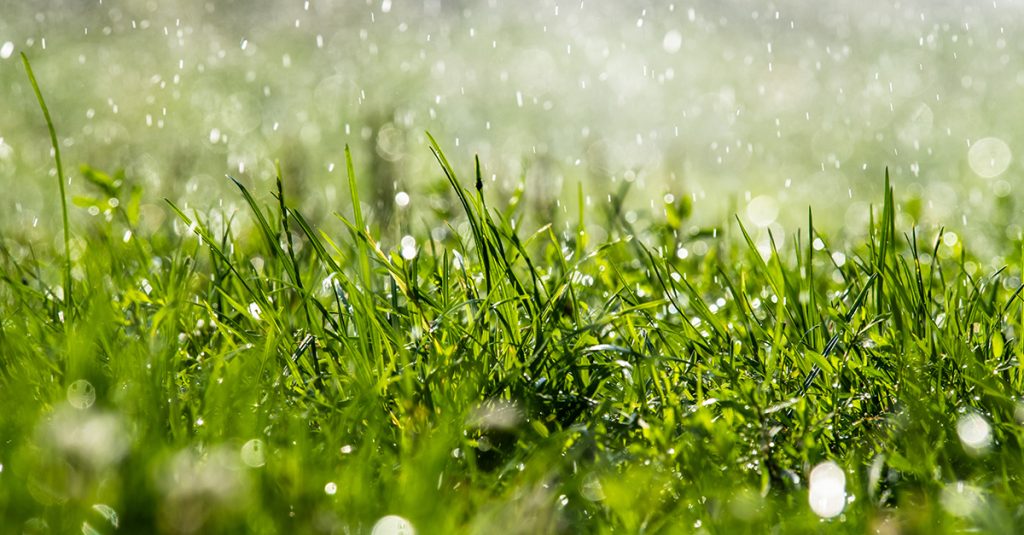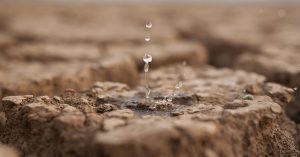It Smells Like Rain – by Dr Hanns Froehlich PhD May 15, 2024

Everyone knows it, the “smell of rain”, when the first raindrops fall on the ground after a long dry spell. But how does this remarkable smell come about?
As soon as the first raindrops fall on the ground, you can already smell it in your nose – the earthy, fresh, and slightly damp “scent of rain”.
Everyone knows this “rain scent” and most people find it pleasant. But what do you actually smell?
Raindrops consist of water, i.e. H2O, and this is known to be odourless. Apparently, many decades ago, people were already asking themselves exactly this question. In 1964, the two Australian scientists, I.J. Bear and R.G. Thomas, published a paper in “Nature” and created the name “petrichor”. This name is derived from the two Greek words “petros” (engl.: stone) and “ichor” (engl.: liquid in the veins of the Greek gods).1
 In this study, the two researchers were able to identify an essential component of the smell of rain. They found that plants produce and secrete a yellowish oil during dry phases and secrete it during dry periods. This essential oil is absorbed by soils and rocks (hence the name component “petros”), including pavements, and also from sidewalks and roads.
In this study, the two researchers were able to identify an essential component of the smell of rain. They found that plants produce and secrete a yellowish oil during dry phases and secrete it during dry periods. This essential oil is absorbed by soils and rocks (hence the name component “petros”), including pavements, and also from sidewalks and roads.
Recent studies have shown that another substance is responsible for the odour. It is an alcohol called “geosmin”, which is produced by bacteria in the soil.2
These microorganisms reduce their metabolism to the bare minimum when it is hot and dry. As soon as the bacteria come into contact with water, they become active again and release – among other things – the volatile and strong-smelling “geosmin”. It happens also, that dew on a cool spring morning is enough to activate the bacteria. Together with the essential oil of the plants and dust on stones, this creates the well-known earthy and fresh aroma of the “petrichor”.
In 2015, researchers from the Massachusetts Institute of Technology (MIT) used high-speed cameras to discover another important effect that explains the intense odour. When the raindrops hit the dusty ground, small air bubbles form in which the air bubbles are formed in which the with and tiny odour particles are trapped inside. However, these bubbles burst quickly and even a slight breeze or air turbulence is enough to spread the aroma in the air. Incidentally, the same effect also causes the intense odour when opening bottles of sparkling wine or soft drinks, as the rising carbon dioxide bursts and spreads the scent of the drinks.3
 The intensity of the petrichor depends on the porosity and moisture of the soil. If the soil has many cavities and is very dry, this is conducive to a rain aroma. The best prerequisite is light rain that falls on a fine-pored and dry soil, from which numerous particles can be released. This is why you can usually smell the rain after long dry periods of drought or in summer during thunderstorms when the heat has previously dried the soil out considerably. In addition to clay soils, forest soils are good sources of an intense scent, as these types of soil contain sufficient cavities from which the air bubbles can rise. However, if it rains very heavily or for long periods, then the soil is quickly soaked and a layer of water forms over the soil, through which no more air bubbles can rise. Hence the scent of rain dries up or does not appear at all. Occasionally you can smell the petrichor some time before the rain falls and even when the rain does not fall. If, for example a line of thunderstorms is approaching in summer, then you can often feel the cold outflow from the line of thunderstorms, which carries the smell of rain and sometimes even blows the odour to regions that don’t get any rain at all.
The intensity of the petrichor depends on the porosity and moisture of the soil. If the soil has many cavities and is very dry, this is conducive to a rain aroma. The best prerequisite is light rain that falls on a fine-pored and dry soil, from which numerous particles can be released. This is why you can usually smell the rain after long dry periods of drought or in summer during thunderstorms when the heat has previously dried the soil out considerably. In addition to clay soils, forest soils are good sources of an intense scent, as these types of soil contain sufficient cavities from which the air bubbles can rise. However, if it rains very heavily or for long periods, then the soil is quickly soaked and a layer of water forms over the soil, through which no more air bubbles can rise. Hence the scent of rain dries up or does not appear at all. Occasionally you can smell the petrichor some time before the rain falls and even when the rain does not fall. If, for example a line of thunderstorms is approaching in summer, then you can often feel the cold outflow from the line of thunderstorms, which carries the smell of rain and sometimes even blows the odour to regions that don’t get any rain at all.
You can literally smell the rain from afar!
Finally, a little curiosity: petrichor can even be used as a fragrance in candles, as bath bubbles, or as an additive in humidifiers. Even eau de parfums imitate this scent.
 Dr Hanns Froehlich PhD has worked in business development and sales in the flavour and fragrance industry for over 33 years. During the past 10 years, his focus has been on essential oils. His doctoral thesis was entitled “Interface Management Between R&D and Marketing in the Fragrance Industry”. Dr Froehlich lives in Germany and has four children. His hobbies include music, history, meteorology, and sport.
Dr Hanns Froehlich PhD has worked in business development and sales in the flavour and fragrance industry for over 33 years. During the past 10 years, his focus has been on essential oils. His doctoral thesis was entitled “Interface Management Between R&D and Marketing in the Fragrance Industry”. Dr Froehlich lives in Germany and has four children. His hobbies include music, history, meteorology, and sport.
1: I.J. Bear, R.G. Thomas: Nature of Argillaceous Odour. In: Nature. Band 201, März 1964, S. 993– 995, doi:10.1038/201993a0 (englisch): “The diverse nature of the host materials has led us to propose the name ‘petrichor’ for this apparently unique odour which can be regarded as an ‘ichor’ or ‘tenuous essence’ derived from rock or stone […] it does not imply that petrichor is necessarily a fixed chemical entity but rather it denotes an integral odour, variable within a certain easily recognizable osmic latitude.”
2: Becher, P.G. et al.: Developmentally regulated volatiles geosmin and 2-methylisoborneol attract a soil arthropod to Streptomyces bacteria promoting spore dispersal. In: NATURE MICROBIOLOGY | VOL 5 | JUNE 2020 | 821–829 | www.nature.com/naturemicrobiology
3: https://news.mit.edu/2015/rainfall-can-release-aerosols-0114
 Ultra International B.V.
Ultra International B.V.